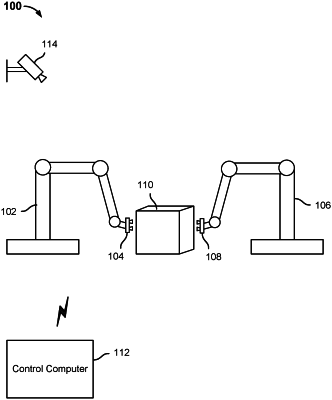| CPC B25J 9/1682 (2013.01) [B25J 9/0087 (2013.01); B25J 9/1669 (2013.01); B25J 9/1697 (2013.01); B25J 13/08 (2013.01); B25J 15/0616 (2013.01)] | 20 Claims |

|
1. A robotic system, comprising:
a first robot comprising a first robotic arm having a first end effector; and
a second robot comprising a second robot arm having a second end effector,
wherein the first robot is configured to determine to perform a task cooperatively with the second robot, move independently to a first grasp position to use the first end effector to grasp an object associated with the task, receive an indication that the second robot is prepared to perform the task cooperatively, and move the object independently of the second robot in a leader mode of operation along a first trajectory determined by the first robot, wherein to move the object independently of the second robot in the leader mode of operation along the first trajectory determined by the first robot, the first robot is configured to provide position and orientation information of the first end effector relative to the object associated with the task, and
wherein the second robot is configured to assist the first robot in performing the task cooperatively, at least in part by moving independently to a second grasp position, using the second end effector to grasp the object, and cooperating with the first robot to move the object, at least in part by operating in a follower mode of operation to maintain engagement with the object as the first robot moves the object along the first trajectory, wherein cooperating with the first robot to move the object, at least in part by operating in the follower mode of operation to maintain engagement with the object as the first robot moves the object along the first trajectory includes receiving the position and the orientation information of the first end effector relative to the object associated with the task and computing a new target position and orientation for the second end effector based in part on the received position and the received orientation information of the first end effector relative to the object associated with the task and information about the object associated with the task.
|